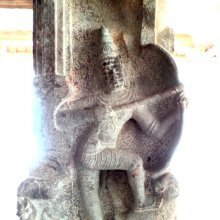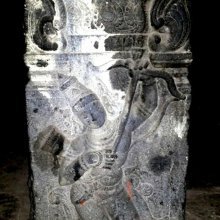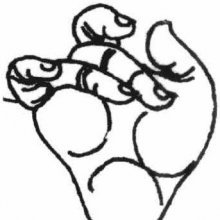Shooting: 3 definitions
Introduction:
Shooting means something in Hinduism, Sanskrit, the history of ancient India, Hindi. If you want to know the exact meaning, history, etymology or English translation of this term then check out the descriptions on this page. Add your comment or reference to a book if you want to contribute to this summary article.
Images (photo gallery)
In Hinduism
Natyashastra (theatrics and dramaturgy)
Source: Shodhganga: Elements of Art and Architecture in the Trtiyakhanda of the Visnudharmottarapurana (natya)Shooting (of an arrow or a spear) is associated with Śukatuṇḍa-hasta: one of the twenty-two Single-hand Gestures (in Indian Dramas) (known as asaṃyuktahastas), according to the Viṣṇudharmottarapurāṇa, an ancient Sanskrit text which (being encyclopedic in nature) deals with a variety of cultural topics such as arts, architecture, music, grammar and astronomy.—The word śukatuṇḍa is the amalgamation of two words viz., śuka and tuṇḍa. Śuka means parrot and tuṇḍa means head. [...] In the Abhinayadarpaṇa, this hand gesture is said to be used in shooting of an arrow or a spear. Moreover, it is used to do the acting of recollecting home or the violent mood. This book also establishes that through this posture one can present spiritual topic.

Natyashastra (नाट्यशास्त्र, nāṭyaśāstra) refers to both the ancient Indian tradition (shastra) of performing arts, (natya—theatrics, drama, dance, music), as well as the name of a Sanskrit work dealing with these subjects. It also teaches the rules for composing Dramatic plays (nataka), construction and performance of Theater, and Poetic works (kavya).
India history and geography
Source: Singhi Jain Series: Ratnaprabha-suri’s Kuvalayamala-katha (history)Shooting (animals with bow) represents a scene of human life commonly depicted on the Saṃsāracakra paintings, in ancient India, as mentioned in the Kathās (narrative poems) such as Uddyotanasūri in his 8th-century Kuvalayamālā (a Prakrit Campū, similar to Kāvya poetry).—Page 185.21 f.: Here follows a description of a printed scroll illustrating the Jaina conception of saṃsāracakra. [...] The saṃsāra-cakra illustrated the three worlds of hell, human world and the world of gods. [For example:] Persons shooting animals with bow and arrow; a person holding a naked sword and showing feats of swordsmanship; parrots and magpies put in cages for amusement

The history of India traces the identification of countries, villages, towns and other regions of India, as well as mythology, zoology, royal dynasties, rulers, tribes, local festivities and traditions and regional languages. Ancient India enjoyed religious freedom and encourages the path of Dharma, a concept common to Buddhism, Hinduism, and Jainism.
Languages of India and abroad
Hindi dictionary
Source: DDSA: A practical Hindi-English dictionaryShooting in Hindi refers in English to:—(nf) shooting (of a movie film etc.)..—shooting (शूटिंग) is alternatively transliterated as Śūṭiṃga.
...
See also (Relevant definitions)
Query error!
Full-text (+435): Alidha, Vaishakha, Pratyalidha, Sarasana, Parisphurana, Samapada, Sharaghata, Vyavaccheda, Khatakamukha, Prarohin, Vishakhala, Sphuradulka, Radha, Vishakha, Vimoksha, Chunachunata, Potatidika, Khalla, Durapata, Shinika.
Relevant text
Search found 148 books and stories containing Shooting; (plurals include: Shootings). You can also click to the full overview containing English textual excerpts. Below are direct links for the most relevant articles:
Garuda Purana (by Manmatha Nath Dutt)
Chapter LXXIII - Tests of Lapis Lazuli (Vaidurya) < [Agastya Samhita]
Chapter CLV - The Nidanam of diseases resulting from the excess or abuse of wine < [Dhanvantari Samhita]
Chapter CXLIII - The Ramayana < [Brihaspati (Nitisara) Samhita]
Amarakoshodghatana of Kshirasvamin (study) (by A. Yamuna Devi)
Education (10): Knowledge in Archery < [Chapter 4 - Cultural Aspects]
Maha Buddhavamsa—The Great Chronicle of Buddhas (by Ven. Mingun Sayadaw)
Part 5 - The Archery Display < [Chapter 2 - The Performance of the Ploughing Ceremony]
Part 4 - The Week at the Golden House (Ratanāghara Sattāha) < [Chapter 8 - The Buddha’s stay at the Seven Places]
Part 1 - Story of Sumana, the Flower Seller of Rājagaha < [Chapter 21 - Story of Sumana, Aggidatta and Jambuka]
Notices of Sanskrit Manuscripts (by Rajendralala Mitra)
Page 209 < [Volume 9 (1888)]
Yavanajataka by Sphujidhvaja [Sanskrit/English] (by Michael D Neely)
Verse 3.8 < [Chapter 3 - One’s Own Form of the Drekkāṇas]
Nitiprakasika (Critical Analysis) (by S. Anusha)
Dhanus (Bow) < [Chapter 3]


